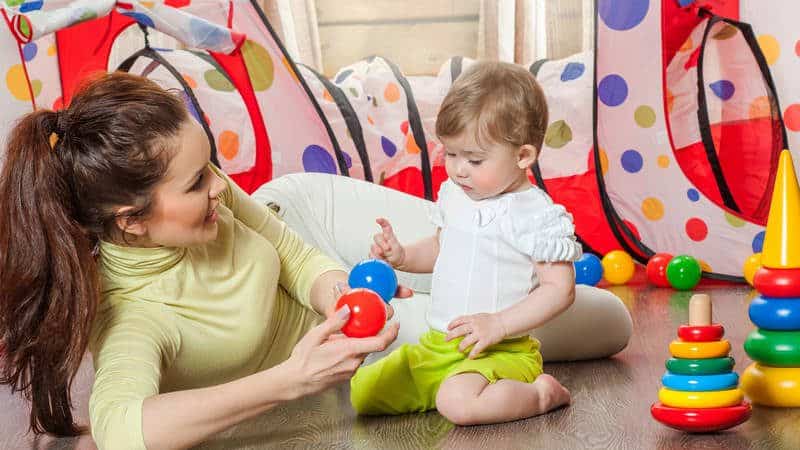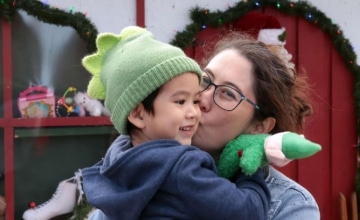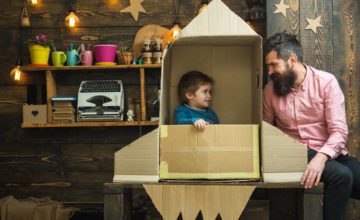By Claire Lerner
While toddlers are a lot of fun, there is also this truth: There may very well be no more sleeping in for you until your kids are teenagers. Browse the information and links below to see what your little one is experiencing and learning this month.
What It’s Like for You
Rafik, father to 23-month-old twins Amari and Aaliyah, wonders:
What’s it like to sleep in on the weekends? I don’t think I can remember back that far. I was just talking to a friend who doesn’t have kids and he was complaining about how his neighbor’s dog woke him up so early last Saturday—at 8:30 am! I was thinking, if I ever get to sleep until 8:30 again it will be a miracle. Somehow I figured that once the girls were closer to 2, they’d sleep a lot later but they are still up and ready to play at 6 or 6:15 most mornings.
While toddlers are a lot of fun, there is also this truth: There may very well be no more sleeping in for you until your kids are teenagers (when you’ll be waking them up—as hard as that is to imagine). Some toddlers—in fact, most—tend to be early risers, often because they have gone to bed several hours before you and have already slept their needed 10 to 12 hours. But that doesn’t make 6 am any easier for you. Lack of sleep, for days and months, is one of the toughest parts of parenting. You’ve heard all the suggestions: Get to sleep early, exercise regularly, take naps—if you can. Unfortunately, reality often gets in the way of the best advice. So, until your early bird is old enough to press the snooze button, put on the coffee and pull out a big mug. There is something to be said for watching the sun rise while cuddling with your favorite little person.
What It’s Like for Your Child
My friend, Nia, came over to play today. At first, I felt shy and hung on to Mommy’s legs. She kept saying, Go say hello to your friend, but I didn’t want to. It felt strange to see my friend from preschool in my house. Then we all went into the family room where my toys are. Nia started playing with my toy dishes. I watched her for a little while. Then I started playing next to her with my toy food. After a little while, Nia started playing with my trucks. She started pushing my favorite truck around the room. I grabbed it out of her hands and she started to cry. Then Mommy took it out of my hands and said we had to take turns. So I started to cry too. Mommy handed me my truck that honks. At first, I didn’t want to play with it but she honked it a few times, then I honked it, and it was funny. So Nia and I started pushing trucks all around the house. We stopped in the kitchen and I showed her how I can pull a stool over to the counter. We climbed onto it and took a few of the cookies Mommy and I had made for Nia’s visit. They were so good! When Mommy came in the kitchen, she said, You two have been awfully quiet. When she saw us on the stool, I said: Look, Mommy! Snack! Nia and I laughed and Mommy did too.
What Your Toddler Is Learning
Social-Emotional Skills:
- Friendship-building skills, when the two toddlers play next to, but not with, each other, which is typical for this age
- Sharing and cooperation, when Nia’s mom helps her accept her friend playing with her favorite truck and agrees to play with another truck
- Early practice with manners, when her mother suggests that she greet her friend at the door
Language and Thinking Skills:
- Putting words together into short sentences to convey thoughts and ideas (Look, Mommy! Snack!)
- Motor planning skills—the ability to plan a series of actions to reach a goal, like pulling the stool over to reach the cookies
- Cause and effect—understanding that pressing the button makes the truck honk
Physical Skills:
- Large motor skills (using the large muscles in the arms and legs), as she pulls the stool over and climbs up to reach the cookies
- Balance and coordination, as she stands on the stool
What to Expect From Your Baby’s Development
As you review the chart, keep in mind that development is not a race and that every child grows at her own pace and in her own way. Your child may develop skills faster or slower than indicated below and still be on track. If you have questions or concerns, talk with your child’s health care provider or other trusted professional.
Your Toddler’s Development From 18 to 24 Months
| What Your Baby Can Do | What You Can Do to Connect With Your Baby |
|---|---|
I am learning new words everyday. |
|
|
|
I can use my hands and fingers to do so many new things. |
|
|
|
I am learning about my own and others’ feelings. |
|
|
|
I am beginning to use my imagination. |
|
|
|
I am a little scientist, always testing things out! |
|
|
|
Did You Know…
You can expect your child’s first two-word sentence right about now—between about 21 and 24 months of age? While children generally follow the same steps in developing language, timelines differ. For example, one study found that 10 percent of 24-month-olds have a vocabulary of more than 550 words, but another 10 percent speak fewer than 100 words—more than a fivefold difference.
What the Research Means for You
- Your child has a lot to say, whether it’s Dada, up! Or, Me cookie, or the all-time favorite toddler combo, No! Mine! As you listen to your child talking, you’ll be amazed at how much he can communicate using just a few words, gestures, and facial expressions. To continue building your toddler’s language skills, you can:
- Expand on his sentences. If he says, Dada up!, you can say: You want me to pick you up. You want to see out the window. Responses like this help your child learn new words, phrases, and rules of grammar.
- Play pretend. Role-playing (like when the two of you pretend to cook food to feed your child’s stuffed bear) creates lots of opportunities for using language. You can ask questions: What is Bear’s favorite food?; and talk about what you are doing together: You are putting Bear in his bed now. He must be very sleepy after his big meal. Over time, these kinds of interactions build your child’s language and thinking skills, too.
- Change the words. Take your child’s favorite songs and change the words. Wheels on the Bus can become Babies in the Bath. And as one parent of a truck-loving toddler found, Twinkle Twinkle Little Star can, with a little tweaking, become Stinky Stinky Little Garbage Truck.
Spotlight on: Choosing a Preschool Program for Your Child
Many parents of 2-year-olds are considering registering their child for some form of preschool beginning between ages 2 and 3. You may be wondering how to know whether a program is “right” for your child. The following steps can guide you in making a good choice for your child and family.
Step One: Look for Responsive Care
Research shows that the quality of the caregiver or teacher is one of the most important factors in nurturing a young child’s development. Therefore it is very important to find a program with skilled, sensitive, and responsive early childhood professionals who will take the time to get to know your child. The best teachers are able to adapt their approach to your child’s individual needs and temperament. Responsive caregivers wonder why a particular behavior is occurring, come up with an educated guess, and test out different strategies to find what works best for your child. Is a crying toddler tired? Hungry? Overwhelmed? Lonely? Frustrated? They avoid one-size-fits-all responses and try to figure out what is happening (and why) with an individual child.
Responsive caregivers also follow the children’s lead and build on their interests, which is the best way to nurture children’s curiosity and help them learn. For example, a caregiver who notices that the children are especially interested in playing in the dirt might help the children plant a small garden (indoors or out) so they can see the connection between digging, planting, and growth.
These caregivers also nurture children’s learning through everyday routines. For example, if your toddler is protesting a diaper change, they may comfort or sing to her instead of just changing the diaper as a chore with minimal interaction. These kinds of experiences provide needed distraction while also encouraging learning and bonding throughout the day.
Before making a decision, visit the program to watch how teachers and caregivers interact with the children. Parents can learn a lot about a program simply by observing. Here are some specific criteria to look for when visiting a child care program:
- Do the teachers seem to enjoy children? Do they join in their play and look like their having fun?
- Do teachers answer children’s questions patiently? Do they ask children questions?
- For toddlers, is a daily schedule posted, using pictures and visuals, so that children can anticipate what will happen next?
- Is there a good balance between group activities and individual or “free” play?
- How do caregivers use everyday moments for learning and skill development (for example, reading stories at nap time)?
- How do caregivers build on children’s interests to help them learn?
- Do teachers interact with children on different levels—individually, in small groups, and as a class?
- Do caregivers track children’s development through photos, noting children’s comments, and art displays? Do they provide formal progress reports to parents at least twice each year?
- How does the teacher feel about discipline? Weaning? Toilet training? Feeding? Do the teacher’s beliefs and strategies match your own or feel comfortable to you?
- Does the teacher handle conflicts without losing patience, shaming a child, or frequently displaying anger?
Step Two: Evaluate the Preschool Program
Preschools may have a lot in common (like wooden blocks and dress-up clothes) but are also very different in important ways. For example, their curriculum and activities may be influenced by different philosophies. If you are choosing a program with a specific educational or child development philosophy, learn all you can about it to ensure that it fits with your own beliefs and values and is comfortable for you and your child. For example, a child who has challenges with self-control will likely do better in a program that provides a lot of structure. Or, if a program requires significant parental involvement and volunteering and you work full-time, these time commitments may be difficult to fulfill.
Also consider the look and feel of the school as a whole. Is it warm and friendly, or more cold and institutional looking? Are you greeted by children’s artwork on the walls? Do staff members smile and say hello? Are the facilities well-maintained? Is there adequate outdoor playspace for the children? How much outdoor time do children get each day?
In the classroom, is there an acceptable noise level? Are children busy, happy, and involved in activities? Are there plenty of materials at the child’s level to stimulate interest and curiosity?
Step Three: Confirm Licensing, Staffing and Safety Issues
These are the nitty-gritty details that ensure your child’s experience in preschool is a safe and healthy one. While the following may seem like a lot to investigate, it is well worth the time it takes to get this information as changing programs can be a challenging process for you and your child.
Licensing Issues
Each state has different licensing requirements for programs and providers. The good news is that a growing number of states are providing quality rating systems for child care programs, so you might want to ask centers you are considering if they participate in this.
Listed below are some initial questions to ask when selecting a child care program. For more information on licensure, you can visit the National Association for Child Care Resource and Referral Agencies. Questions to ask include:
- Is the child care program licensed by the state or local government?
- Is the child care program accredited by the National Association for the Education of Young Children or the National Association of Family Child Care?
- Are the caregivers certified by the Council for Early Childhood Professional Recognition with a Child Development Associates degree credential for infant-toddler caregivers? Do caregivers possess an equivalent credential that addresses comparable competencies (such as an Associate’s or Bachelor’s degree)?
A growing number of states are providing quality ratings for child care programs. If you live in one of these states, you can ask about the quality rating for the child care program you are considering.
Staffing Issues
- Does the program adhere to state-regulated caregiver/child ratios? What is the size of your child’s group?
- Is the turnover rate for families under 20%? Why do families leave?
- What is the staff turnover rate? Are there staff retention strategies in place? (The reality is that staff turnover is likely to be high—50 to 75 percent is not uncommon. Look for a program that will be honest with you about turnover, but will also share their strategies for keeping skilled staff.)
- When caregivers leave, do they help children understand the transition through activities like good-bye parties, reading books about separation, and taking photos of the departing caregiver? Does the new caregiver have a chance to spend time with the departing caregiver to learn about the children?
- Does the program offer standard medical benefits and vacation leave? Does it support caregivers’ continuing education through tuition reimbursement programs and/or by sponsoring staff at regional/national conferences on early childhood development?
Ask the program director or a caregiver to tell you about an experience they’ve had that made them feel really proud of the care they offer.
Health and Safety Issues
- Is there a secure sign-in/sign-out procedure for dropping off and picking up children?
- Are all doors and play areas secure—locked and/or fenced?
- Does the program have regular fire drills? Has the program developed an evacuation plan, in the event one is needed?
- Are all staff trained in basic first aid and CPR?
- Are diapering, sleeping, food preparation, and play areas separate?
- Are there clearly written sanitation procedures specific to each area? Are there instructions posted on proper diapering and food storage/preparation procedures?
- Are toys washed and disinfected regularly?
- What is the sick-child policy?
References for this section:
- Parlakian, R. (2001). Matching your infant or toddler’s style to the right child care setting. Washington, DC: ZERO TO THREE.
- Choosing a Preschool or Child Care Center
- Five Tips on Choosing a Preschool
Let’s Play: Activities That Nurture Bonding and Learning
You’ve Got Mail
Give your toddler some markers, paper, and envelopes. Let her draw/write/scribble on the paper and envelopes, making her own “letters.” Help her put a piece of paper in each envelope and seal them with stickers or a glue stick. Create mailboxes from shoeboxes or baskets you have around the house. Let your child deliver the mail to you, to her stuffed animals, or to herself! Later, see if she’d like to help you mail a real letter at the post office.
Take a Closer Look
Tape two toilet paper tubes together to form a pair of binoculars. Toys like this build on your toddler’s growing imagination. Take your toddler to the park or on a walk to “see what you can see” through your new fieldglasses. You can announce that you’ve spotted…someone you love very, very much. Can your child guess who that is?
What’s on Your Mind?
1. My 23-month-old son spends a lot of time interacting with my 4-year-old son and his friends. While they play together pretty well, there are times when the 4-year-olds are doing activities that are hard for my 2-year-old to do, such as climbing jungle gyms. Should I find more games for them to play together, or just not worry about it?
Congratulations! Given the fact that sibling rivalry is one of the biggest challenges parents face, especially in the early years, you have obviously done something very right if you have boys 2 years apart who want to play together! And your 4-year-old is willing to include his younger brother in play with his friends? Keep it up—you’ve got some sibling magic going on.
And don’t worry about finding activities your boys can do together—there are plenty of choices. By age 2, most children are very involved in the world of pretend and can start to develop stories using props such as dress-up clothes, action figures, stuffed animals, and the like. You can encourage them to develop pretend stories together, for example, by giving them blocks to build with outside. They can use these structures as props for their pretend play: garages for cars, buildings or houses for figurines, caves or barns for animals.
Look for activities that can be easily modified to meet both your 2-year-old’s and 4-year-old’s different skill levels, like a backyard obstacle course with challenges of varying difficulty. (For example, your older son can climb over a cardboard box while your younger son runs around it.) Games like catching bugs, making mud pies, and building tents out of blankets and furniture will likely appeal to both boys’ range of interests and abilities. Outdoor games like ball kicking and bike riding (one on training wheels, the other on a tricycle) may also be great fun for them.
As much as your boys seem to enjoy playing together, keep in mind that it’s important to let your older son choose not to play with his younger brother sometimes. Always having to include a sibling can build resentment and ultimately backfire, as the older sibling often ends up feeling like the younger one is an intrusion and a “pain.” It’s both fair and reasonable to give your older child some time to spend alone with his friends.
It’s equally important for your younger son to have time to play with kids his own age. As much as he may enjoy playing with the older guys, the dynamics are simply different when you are the younger, smaller playmate. He is probably more of a follower in these play situations, and it’s likely that his needs and interests are not always at the forefront of their play. Interacting with his peers gives him a chance to feel comfortable playing with kids his own age. It also helps him learn how to negotiate, cooperate, and share in a play environment where there is a more equal balance of power.
2. My 23-month-old used to be a great sleeper. But since we had a new baby, she has been getting up multiple times a night. This is driving me crazy. What can I do?
While a sibling is a gift to your older child, she likely doesn’t appreciate this quite yet. Sharing your attention, your lap, and your love doesn’t seem like much of a gift. Since children this age don’t have the ability yet to reflect on and talk about their feelings, they “act out,” expressing their feelings through their behavior. Toddlers who are adjusting to a new baby in the family often act out by regressing in one area or another, be it sleep, potty-training, or by returning to more “baby-ish” behaviors like using a pacifier or bottle again, or wanting to be held and carried. Waking at night provides the attention they miss during the day and the reassurance that they’re still loved and cared for.
To let your toddler know she is still important, make sure both you and your husband each have some one-on-one time with her every day, even if only a short period is possible. Make her feel needed and included. Ask her to get the diaper when it’s time to change the baby or pick out baby’s clothing. When you feed the baby, ask your daughter to pick out a book and turn the pages while you read to her.
At bedtime, establish a consistent routine for your older child so she doesn’t become overtired and find it even harder to fall and stay asleep. While it’s difficult, avoid postponing bedtime, which often happens as a family adjusts to having a newborn in the house again. When your child wakes at night, keep her in her room and gradually decrease the amount of support she needs to fall back asleep. Peek your head in, tell her everything is okay, and that it’s time to go back to sleep. After the second or third waking, call to her from the hallway—Mommy’s here. Everything’s okay. I love you. Time to go back to sleep. Decide how many times you will repeat this, then let your daughter know you are going back to sleep yourself and stop responding. Another strategy is to sit in her room with her until she falls asleep, but without talking, singing, or cuddling. Each night, move your chair further from her bed until you are completely out of the room. The idea is to let her know she is safe and loved but not to make waking up at night a rewarding, fun experience.
Expert Reviewers
- Terrie Rose, PhD, President and Founder, Baby’s Space
- Ross Thompson, PhD, Professor of Psychology, University of California at Davis
- Robert Weigand, MS, IMH-E, Director, Child Development Laboratory, Arizona State University





